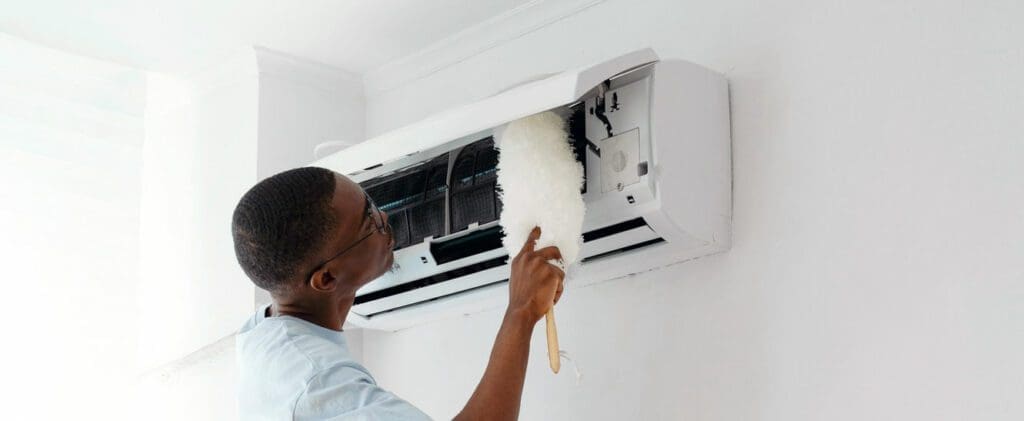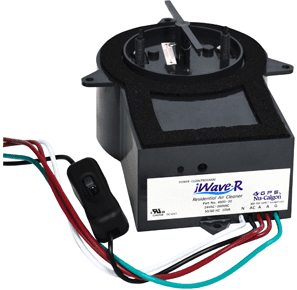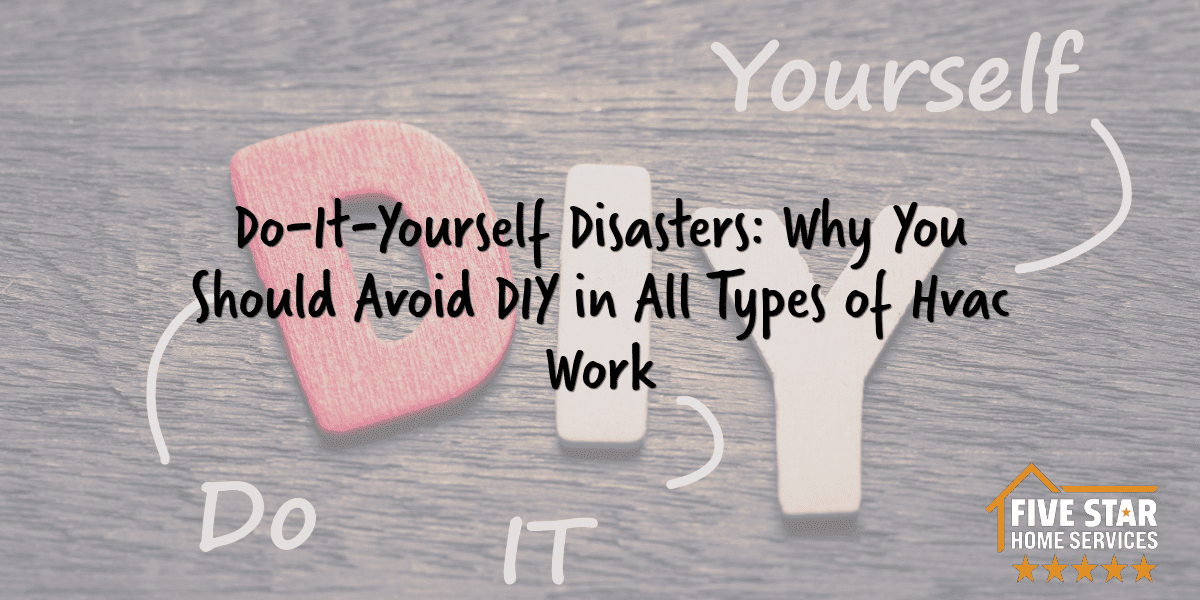In an age when it seems like everyone is going DIY, we have to advise homeowners against this when it comes to their home comfort equipment and indoor air quality products.
Although Do-It-Yourself solutions can be very tempting, they come with their own safety and financial risks for those who aren’t prepared. As your friendly local home comfort experts in Central and Southwest Ohio, we at Five Star Home Services will now run through when and why you should avoid DIY HVAC solutions.
Why You Should Avoid DIY in HVAC Maintenance, Repair & Installation
Being handy comes in very handy when you own a home. You save time money, and gain the personal satisfaction of doing the job yourself. Best of all, in today’s age of information, there are all sorts of “Do-It-Yourself HVAC” videos online. You can learn anything on YouTube, which has effectively de-centralized education. Although we haven’t vetted each one, we do know that there’s a growing interest in DIY heating and air conditioning projects.
Because of this, in the following, we will also discuss several steps that are safe for homeowners to take on their own. We will outline the risks of doing HVAC work yourself and discuss why a licensed professional is usually necessary.
Because working with HVAC equipment can be a lot more complicated than people realize, it can also be very dangerous. You can mess things up in a hurry. You can find yourself immersed in electrical work, metalwork, and wood work. It can include dangerous gases and refrigerants. Heck, sometimes even plumbing skills are necessary. Because of all this, all HVAC work requires the right tools and expertise.
Although there are other industries that hide behind professional services that aren’t necessary (some of these you can do the work yourself), HVAC isn’t one of them. In the following, we will demystify this topic to give you some considerations before going on to tackle any sort of HVAC project.
Licensure & Warranties in HVAC
The main reason we can’t recommend DIY work is because a lot of HVAC work is tied to manufacturer warranties and professional licensure. At best, you could end up voiding your warranty (often 10 years) on equipment by doing something yourself. At worst, the work you do could be illegal. It’s not worth it!
HVAC warranties aren’t just tied to installations; they apply to maintenance as well. Take your air conditioning system, for instance. Maybe you’re not brave enough to install one on your own (and rightly so, hat’s being smart!), but what about servicing your own equipment? Sure, you can look up how its done online. However, you will be voiding the warranty by skipping maintenance from a licensed professional like Five Star. Keep in mind that professional maintenance isn’t merely for show. Home comfort equipment is finely tuned to certain pressures and specific levels. To get the most out of your equipment, and keep it all in working order, professional expertise is indispensable.
But let’s say you did it on your own and you end up needing an expensive repair in year eight. If this happens and you avoided professional maintenance, you’re out of luck! Now, the chances of needing an early repair skyrocket. Then, if you factor in that some work legally requires licensure and certification, you have a recipe for disaster if you’re attempting a DIY solution.
Working with a professional contractor like Five Star Home Services, nevertheless, can even give you access to extended warranties. Because of our longstanding relationships with industry leaders and innovators, and because of our bulk buying power, we are able to give you more than the competition.
So What DIY Projects Can You Do in HVAC?
Most homeowners know it’s ok for them to replace their furnace filter. That’s obvious. You can also control your heat and cool air through the thermostat. Another no-brainer. However, are there other things you can do?
In short, the answer is yes. There are other things to consider and we’ll touch on those below.

Although we’ve seen video tutorials on cleaning your own outdoor air conditioning unit — there is simply no substitute for a full diagnostic or full maintenance visit from a trained professional. We cannot over-emphasize this. Granted, if you’re rinsing off your outdoor AC equipment or removing leaves from it, this is fine. Clearing growth and debris will help you avoid costly repairs. To ensure airflow, there should be at least three feet of space surrounding your outdoor equipment so be sure to cut down anything getting close.
Managing your control systems is another important function of an HVAC system. A lot of homeowners feel intimidated by the fancy options on some of the newer, digital devices. Nevertheless, it is strictly your responsibility to understand how they work. When they are being utilized properly, smart thermostats and types of other controls give you diagnostic information that you can use to monitor system health and overall performance. They also allow you to program your temperature for certain times of the day, week, or year.
In the following, we will next discuss indoor air quality products, ductwork, and other types of equipment — all of which generally come with additional risks and considerations. And while this list might not be exhaustive, if the items above are the only HVAC devices you’re working directly in your lifetime, you’ll be just fine as long as you’re working with a trusted contractor like Five Star Home Services to maintain the rest.
Indoor Air Quality Products: DIY vs. Professional Installation
First things first. When we talk about professional installation, we’re talking about whole-home solutions. If you want to purchase a portable humidifier and stick it in your bedroom, or a dehumidifier and put it in your basement, you don’t need an HVAC professional. Nevertheless, we need to remind you that these cheap air quality options aren’t the best solutions for an entire home. They might work for a small area. For instance, a dehumidifier might get rid of excess moisture in the basement. Nevertheless, if your home is perpetually muggy during the summertime, a ducted, whole-house option will be necessary. Or a smaller humidifier might help you sleep at night, but it won’t help with the creaky floorboards or perpetual coughing some people get during the dry, winter months.
And this is where the metalwork comes into play. Then, there’s also electrical work and airflow testing. In some scenarios, a new electrical circuit will need to be created, which requires a licensed electrician. Fortunately, we have state licensed electricians on staff at Five Star Home Services for the work that even HVAC professionals shouldn’t be doing!
UV Lamps, Ionizers & Air Purifiers
At Five Star Home Services, some of the products we endorse and most frequently install is the Reme Halo Air Purifier, the iWave-R and many of our air purifiers. These products proactively neutralize many airborne and surface odors, bacteria and viruses (including COVID-19).
The Reme Halo is an in-duct solution that includes many of the same considerations mentioned above.
The iWave-R is an air-purifying device that can be installed in any duct air conditioning system. Its patented technology, Needlepoint Bi-polar Ionization (NPBI), is used to create a plasma region filled with a high concentration of positive and negative ions. These ions, when traveling through the air in your home or office, will reduce pathogens, allergens, particles, smoke, and odors, thereby improving overall air quality.

In addition to these, there are budget-friendly options for UV lamps to go inside your ductwork but they usually don’t involve as many installation steps. Are these good solutions? Yes, they can be potentially, but much like portable humidity products, they won’t be quite as effective for several reasons.
For one, they’re generally not designed to last as long. Additionally, the location of the install means that it’s not generally treating the indoor condenser coil. This is a key area where mold, bacteria and other irritants can often develop.
Although most of these can be harmlessly installed, it is important that you make sure you read the stipulations of your furnace or air conditioner warranty to make sure you’re not making it invalid.
Keep in mind, you won’t enjoy the benefits of professional maintenance and repair on most of these devices. Although they can still work for some homeowners, they will not be enough for others who are looking for long-term, holistic solutions for their home.
Ductwork Sealing Strategies and Considerations
Let’s say you are down in your basement on day and suddenly you feel a breeze on your neck. If you were able to trace it to a leak in your ductwork, you’re probably wondering: Can I fix this leaking ductwork on my own?
In short, probably. This isn’t rocket science. The metallic sealing tape you can easily acquire in most hardware stores should provide you with considerable benefits. Nevertheless, this isn’t always a permanent solution.
A professional HVAC installer like Five Star Home Services will use specialized caulk to seal gaps in ductwork better. We also ensure there aren’t any additional leaks because we have all the equipment to measure airflow and air pressure at various points in your HVAC system. This enables us to easily identify problems you’ll never find with the naked eye. Keep in mind, even small leaks add up in terms of comfort and cost-efficiency.
Ductless Mini-Splits: Problems With DIY Solutions
Perhaps you’ve seen some of the commercials for DIY ductless mini-split solutions and you know they’re cheaper than a professionally installed one. What you don’t know, nevertheless, is that there’s a reason for that.
For starters, now you are going to have to do some complex work. This includes carpentry, working with power tools, electrical wires, and ac refrigerant. This last one is the most potentially dangerous. Some refrigerants are flammable. Others dangerous to handle. If you have to add or remove refrigerant because of a longer-than-expected refrigerant line, it requires EPA certification to perform it legally.
While all this is doable, doesn’t is sound like a big headache? That’s a lot of work, and a lot of risk.
The products wouldn’t exist if it wasn’t. And, assuming everything goes well with your DIY installation, it still isn’t likely the new unit will be as efficient as one that was professionally installed by your affordable friends at Five Star Home Services.
Additionally, if you go DIY and fail to install it correctly, you could be replacing it in year three instead of year 15; therefore, you will have far worse performance during those years.
In any case, we don’t mean to sound cliché when we say: “You get what you pay for!” Sure, there are people out there who have saved themselves a little money by installing their own ductless units. But there’s always more to the story. For every success story there are countless failures. There are also many more who have avoided these headaches and kept their peace of mind by working with a trusted, licensed company like your neighborly friends at Five Star!
Furnaces, Air Conditioners, Heat Pumps and Other Major Equipment
If smaller and simpler HVAC equipment has numerous complications — then the larger and more complex equipment has even more.
Those who have the expertise required to install or repair a larger system, are probably licensed HVAC professionals to begin with. HVAC technicians go to school specifically to learn these advanced skills. Because of this, even general contractors and handyman often struggle with the intricacies of proper installation.
As proof, we can happily point you toward our articles on AC installation and furnace installation. We go in-depth more to give you a sense of just how much goes into properly installing and commissioning equipment so that it operates correctly and efficiently.
Benefits of a Professional Installation
By now, we hope you understand one thing: The benefits of a professional installation are obvious and too numerous to list. Outside of the few basic tasks we discussed, homeowners should leave professional HVAC work to the professionals at Five Star. At the very least, if you’re still determined to perform a DIY solution, we hope you’ll take all proper precautions and now have a better understanding of the risks involved.
More importantly than this — there are qualities that separate professional installers and service technicians even once you’ve decided to go with a professional installer. There are safety protocols, training and certifications, tools, and employee practices, all of which make a big difference in what kind of quality you get! Having said that, you might be wondering what are the differentiating factors you should be looking for?
Among others, they include:
- Digital commissioning tools for testing and ensuring accurate pressures in your HVAC system for optimal performance.
- Hourly, W2 employees instead of piece-rate employees who are paid by the job. Hourly employees are incentivized to do the job right where, as piece-rate employees are incentivized to do the job quickly.
- Companies that value continuing education and support their technicians in acquiring advanced certifications such as NATE (North American Technician Excellence) Certification, which is generally considered to be the industry-standard certification for HVAC excellence. We at Five Star Have our in-house trade school at Emerge Recovery & Trade Initiative.
- Strong Google reviews, including attention to the negative reviews. How a company handles and adjusts to dissatisfied customers is just as important as how it handles praise. As our name suggests, we have a near-perfect 5-star rating!
Give us a call!
No matter what your next project is, we would love to sit down and help you find the best solution for yourself, your home, and your family. Give us a call any time at (833) 405-8009! We are always more than excited to meet you and help you build a more comfortable home!

